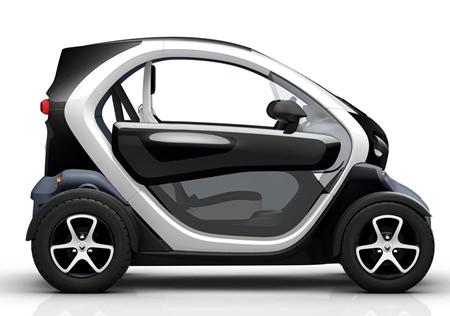Many years ago I bought a Tuk-Tuk and imported it to Australia. A fun run-about. And as soon as the three wheels were on the bitumen, that’s when the trouble started.
Mr. Policeman would stop me and demand to know what it was. I would answer that it was a Thailand Tuk-Tuk, brought over for promotional purposes, and it was registered, complete with number plates and documentation.
There was obviously nothing in Johnny Hop’s book to cover Tuk-Tuk so I was told that if it was a motorcycle, I had to wear a helmet, and as I wasn’t wearing one, he was going to book me.
 Renault Twizy.
Renault Twizy.
However, if it was a car, I had to wear a seat belt, and as I wasn’t wearing one he was going to book me. Friendly lot the Aussie coppers. The end result was that it was all too much hassle and I parked Tuk-Tuk outside my Thai restaurant and left it there.
However, that form of narrow thinking still exists. There is a group of vehicles now called ‘quadricycles’, and since they are registered for road use, they have to be tested by the Euro NCAP people and graded for passenger safety.
These vehicles, and the Renault Twizy is one, are in reality, up-market electric golf carts, to be used as city cars. Twizy’s four wheels and steering wheel would put it into the passenger car category, but its quadricycle classification overseas has enabled it to be developed, and sold, without the same degree of safety features – including side-impact beams and electronic stability control – required for homologation of regular cars in Australia, for example.
By its very nature the Twizy can not offer occupants the same degree of protection as a modern passenger car, and European NCAP quadricycle testing is not directly comparable with star ratings published for passenger vehicles.
However, Euro NCAP has highlighted that Twizy and three other quadricycles tested recently – all type-approved for use on public roads – “showed severe safety problems” in specific tests, including a 50 km/h frontal impact (down from 64 km/h on cars) and 50 km/h side impact (the same speed used when testing cars).
Reality is that these vehicles are four wheel motorcycles with electric battery power. Top speed is around 80 km/h, and the nearest comparison is with motorcycles, not cars. Side impact studies would show that Twizy is much safer than a motorcycle, so NCAP should be promoting the quadricycles, not putting silly rules in their way.
The battery powered two seater Twizy 80 model tested is classified as a ‘heavy quadricycle’ in Europe and requires the driver to have a license. It weighs 474 kg and produces a neck-snapping 13 kW of power and 57 Nm of torque.
Acceleration? It is capable of reaching 45 km/h from standstill in 6.1 seconds, on its way to an electronically limited 81 km/h top speed. Renault claims the vehicle has a driving range of up to 100km before requiring a recharge.
As well as developing a driver’s airbag and a harness-style seatbelt for the Twizy, Renault built in a three-point passenger seatbelt, four-wheel disc brakes, front and rear crumple zones and a ‘safety cell’ body structure.
A number of other manufacturers in Europe and Japan in particular are working on similar electrified vehicles, with some of the concepts and prototypes shown in recent years including the Honda MC-B, Toyota i-Road, Audi Urban Concept, Volkswagen Nils, Opel RAK-e and PSA Peugeot Citroen’s VELV.
One day, those people with legislative powers should look beyond the end of their noses.




